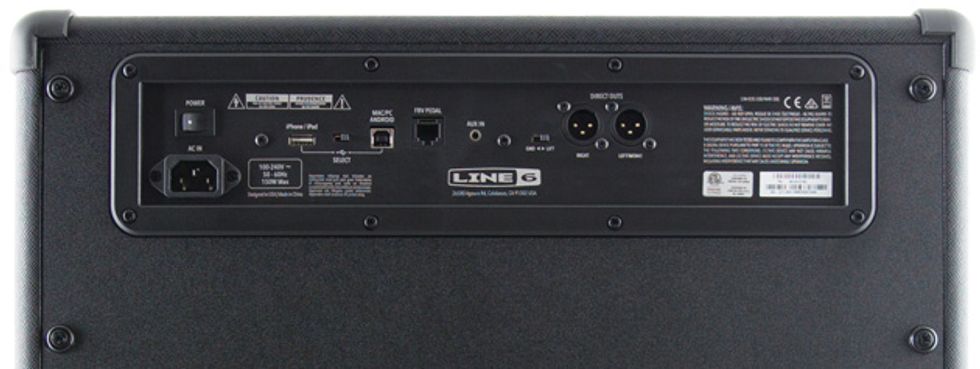Line 6’s first Spider digital modeling amplifiers helped make amp modeling accessible to the masses. With a few twists of a knob, a beginner could conjure a convincing (for the time) Boogie-style tone, the bark of an AC30, or a smooth blackface Twin Reverb sound. Those early Spider amps were a revelation for many. And the Spider V 120 may set a new standard—yet again—for amp-modeling bang for the buck. But to think of the Spider V 120 exclusively as a modeling amp would be a disservice. It’s packed to the gills with features that aid composition and recording, too.
More Here Than Meets the Eye
Behind the amp’s sleek black and silver grille cloth hides a bi-amped full-range speaker system comprised of a 12" and a tweeter, which serve many of the same functions as flat-response monitor speakers. Most of the “speaker” coloration you hear from the Spider comes from the models themselves. Unconventional speaker arrays are also a feature of Line 6’s more expensive Firehawk 1500 and AMPLIFi products. And though the concept is probably counterintuitive to players that fret over differences between regular guitar speaker types, it is key to Spider’s ability to reproduce everything from acoustic-electric guitar sounds to thick bass tones.
In the more relaxed environs of your home or studio, you can also take advantage of the free Spider Remote app (available for iOS and Android) for your smartphone or tablet device. You just plug your phone or tablet into the back of the amp, open the app, and tweak away via the easy-to-use interface. The app makes several of Spider V’s best features, like switching effects order and saving presets, much easier. You can also use the app to share presets and settings with other Spider users.

Another way to record ideas is by utilizing the Spider V’s “quick looper” function. A single button allows you to loop your ideas, play them back, overdub, and erase. You can also use it with a Line 6 FBV 3 foot controller (sold separately) for on-the-fly changes.
Speaking of the FBV 3, I definitely recommend picking one up to unlock the full potential of this amp. The pedal can instantly access your favorite presets—32 banks of four presets each to be exact—and still be able to engage and bypass each effect individually. The expression treadle and footswitches are durable, and have color-coded LEDs that make navigating your tonal changes a cinch on dark stages. The Spider V 120 is wireless-ready and can be used with Line 6’s Relay G10T wireless transmitter (also sold separately).
Ratings
Pros:
Tones far surpass previous Spider amps. Easy-to-use Spider Remote app for editing sounds. Full-range speakers are great for a wide variety of instruments. Cubase LE conveniently bundled in.
Cons:
Traces of digital modeling become apparent and affect amp response at performance volume. Editing sounds from front panel can be challenging.
Tones:
Ease of Use:
Build/Design:
Value:
Street:
$399
Line 6 Spider V 120
line6.com
It’s good practice to never judge the capabilities of digital gear based on factory presets. But the sounds I got right out of the box—and at moderate practice volumes—bucked that logic. The breakup in an old-school Marshall preset was very convincing. A model called “1964 Blackface ’Lux” (I’ll let you sort out the inspiration) responds with a quick and sparkling top, and, even better, some of the touch-responsive sag of a real tube amp. Digital high-gain sounds in affordable modelers can inspire dread, but many of them sounded spot-on here at moderate volumes.
There are many excellent effect simulations, too. The classic distortion, based on a Pro Co Rat, was perfect for fattening up a gritty amp tone. The Phase 90 model swooshed with an appropriate amount of modulation, and changing the cabinet and microphone models not only nailed the characteristics of each piece of gear, but changed the amp’s responsiveness in ways that felt authentic.
Many of the Spider’s sounds are effective in loud live settings.I used the amp on a full-band gig (although I ran direct to the board rather than exploring the limits of the full-frequency speakers). For the show, I pulled up the amp’s 1967 AC30 Top Boost-style model, and placed the Rat-style classic overdrive, a DynaComp-type compressor, a Memory Man-style modulated analog delay, and a thick hall reverb in the signal chain. The amp handled everything without a hitch, eliciting compliments on tone from the other musicians onstage. If there are any complaints to be leveled against the Spider V 120 in the gigging context, it’s that I started to hear discernibly less of the headroom and open, airy top-end that I hear in my tube amplifiers as volume increased. Most of this nuance will be lost on the average listener. For some players, though, the differences in dynamics and sensitivity at volume might affect their overall playing approach.
The Verdict
The Spider V 120 combo amp is so full-featured that I can only profile a fraction of its capabilities in this review. Though there are some minor shortcomings at performance volumes, there are few tones the amp can’t approximate, and most sound pretty terrific—especially given the wallet-friendly price of this amp. Factor in the ease with which you can customize, save, and record sounds, and the Spider V 120 represents a real modeling value.
Watch the Review Demo:








![Rig Rundown: Russian Circles’ Mike Sullivan [2025]](https://www.premierguitar.com/media-library/youtube.jpg?id=62303631&width=1245&height=700&quality=70&coordinates=0%2C0%2C0%2C0)

















